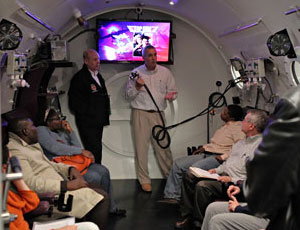Hyperbaric oxygen exposure can produce significant hemodynamic changes. An increase in systemic afterload due to hyperoxic vasoconstriction in well perfused tissues can lead to a decrease in left ventricular function and a decrease in ejection fraction in some patients. When this decrease in left ventricular function occurs in the setting of pulmonary arterial vasodilatation due to improved alveolar oxygenation with increased left atrial and left ventricular filling, acute left ventricular dysfunction and pulmonary edema can result. Cases have been reported in patients with a history of pulmonary edema or low left ventricular ejection fractions or in patients with sudden fluid shifts from volume overload. Acute pulmonary edema appears to be more common in monoplace than multiplace treatment settings, perhaps because of the requirement for patients to be in a more supine position in the monoplace chamber rather than the sitting position with legs dependent available in the multiplace chamber.
Clinical Pearl: Many patients receiving hyperbaric oxygen treatment have severe peripheral arterial disease or diabetes mellitus. These patients are at increased risk for coronary artery disease and occult left ventricular dysfunction. Have a high index of suspicion for prior episodes which could represent congestive heart failure, especially in patients with renal failure, on dialysis, who may be prone to rapid changes in fluid volume. Obtain an echocardiogram in any patient with a history of congestive heart failure, and when abnormal, refer these patients for evaluation and optimization by a cardiologist. While an absolute safe cutoff for left ventricular ejection fraction cannot be defined, patients with ejection fractions of less than 30% should be considered at very high risk for HBOT induced acute pulmonary edema. Weigh renal failure patients daily before HBOT to determine if excessive fluid retention is present. Monitor these patients observationally closely, and have a low threshold to abort treatment at the first sign of respiratory distress.
Reference: Larson-Lohr V, Norvell H, Josefsen L, Wilcox J et al. Hyperbaric Nursing and Wound Care. Flagstaff, AZ: Best Publishing Company; 2010.
Learn More
 |
UHMS Hyperbaric Oxygen Therapy Indications, 13th Edition (book) |
 |
Hyperbaric Nursing and Wound Care (book) |
 |
Introduction to Hyperbaric Medicine 41.0 hour credit course, basic training in hyperbaric medicine. |